What Is Conglomerate? How Does It Form? What Is It Used For?
What is Conglomerate?
Conglomerate is a clastic sedimentary rock that contains large (greater than two millimeters in diameter) rounded clasts. The space between the clasts is generally filled with smaller particles and/or a chemical cement that binds the rock together.
What is the Composition of Conglomerate?
Conglomerate can have a variety of compositions. As a clastic sedimentary rock it can contain clasts of any rock material or weathering product that is washed downstream or down current. The rounded clasts of conglomerate can be mineral particles such as quartz or they can be sedimentary, metamorphic or igneous rock fragments. The matrix that binds the large clasts together can be a mixture of sand, mud and chemical cement.
How Does Conglomerate Form?
Conglomerate forms where a sediment of rounded clasts at least two millimeters in diameter accumulates. It takes a strong water current to transport and shape particles this large. So the environment of deposition might be along a swiftly flowing stream or a beach with strong waves. There must also be a source of large-size sediment particles somewhere up current. The rounded shape of the clasts reveal that they were tumbled by running water or moving waves.
In September, 2012, NASA's Mars rover Curiosity discovered an outcrop of conglomerate exposed on the surface of Mars. The rounded clasts within the conglomerate provide evidence that a stream or a beach had moved the rocks and tumbled them into rounded pebbles. This conglomerate was the most convincing evidence that water once flowed on the surface of Mars. See photo below.
Conglomerates often begins by being deposited as a sediment consisting mainly of pebble and cobble-size clasts. The finer-size sand and clay which fill the spaces between the larger clasts is often deposited later on top of the large clasts and then sifts down between them to fill the interstitial spaces. The deposition of a chemical cement then binds the sediment into a rock.
What is Conglomerate Used For?
Conglomerate has very few commercial uses. Its inability to break cleanly makes it a poor candidate for dimension stone and its variable composition makes it a rock of unreliable physical strength and durability. Conglomerate can be crushed to make a fine aggregate that can be used where a low-performance material is suitable. Many conglomerates are colorful and attractive rocks that are rarely used as an ornamental stone for interior use.
Analysis of conglomerate can sometimes be used as a prospecting tool. For example: most diamond deposits are hosted in kimberlite. If a conglomerate contains clasts of kimberlite then the source of that kimberlite must be somewhere upstream.
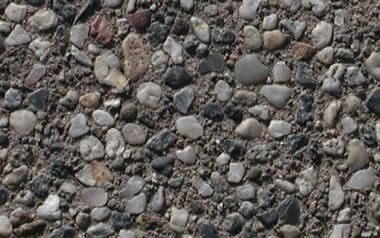
| Conglomerate Close-Up: A detailed view of conglomerate showing the pebble-size clasts with sand and smaller size particles filling the spaces between them. The largest pebbles in this view are about ten millimeters across. Image by the United States Geological Survey. |
Contributor: Hobart King
 |
 |
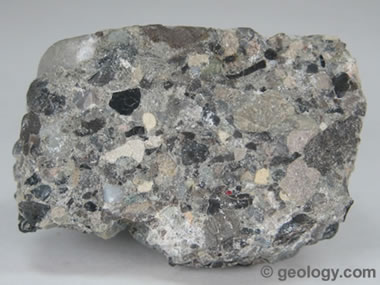
| Conglomerate: The specimen shown is about two inches (five centimeters) across. It is made up of chert and limestone clasts bound in a matrix of sand and clay. |
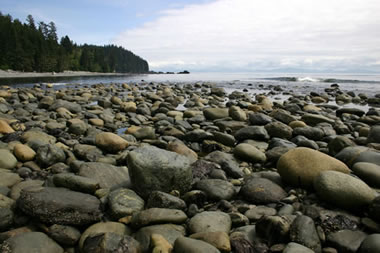
| Conglomerate-Forming Environment: A beach where strong waves have deposited rounded, cobble-size rocks. If buried and lithified these materials might be transformed into a conglomerate. Image copyright by iStockPhoto and Jason van der Valk. |
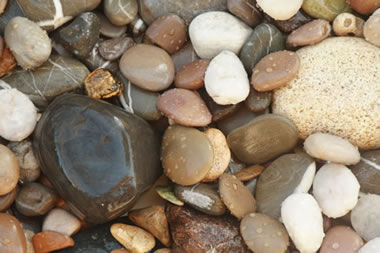
| Conglomerate-Size Sediment Clasts: Pebble-size clasts of many compositions deposited together on a beach. Quartz, sandstone and limestone clasts are all easily recognizable. Largest clast is about two inches (five centimeters) across. Image copyright by iStockPhoto and Ivan Ivanov. |
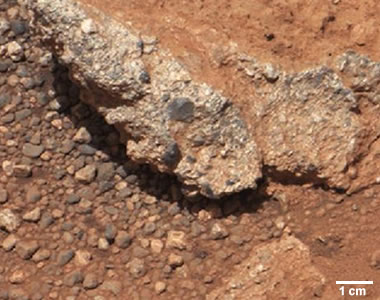
| Martian Conglomerate: This image was acquired by NASA's Curiosity rover on the surface of Mars. It shows an outcrop of conglomerate and some pebble-size weathering debris. The round pebbles are too large to have been moved and shaped by wind, thus they had to have been transported a significant distance by water. This photo from September 2012 was the strongest evidence of the existance of water on Mars that had been obtained at that time. | |